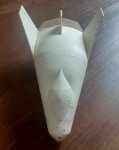I recently found a bunch of public aerodynamic data from the X-24A lifting body as well as some documentation on the SV-5J, a variant of the X-24A meant to be powered by a jet engine that was built but never flew (the test pilot refused to try to fly it). I had been considering attempting an EDF powered build, but was never able to figure out inlet placement since the lift is so dependent on the exact shape of the fuselage being maintained. However, for the X-24A, the body operates more like a conventional wing, so the inlet can be placed below the body with few issues as was done on the SV-5J. In addition, the X-24A has by far the most complete set of aerodynamic data for any lifting body design including extensive wind tunnel data from an 8% scale model which is close enough to the 1/12 scale models that I like to build to ensure dynamic similarity removing any need for analysis on my end. Unfortunately, the X-24A design performs a bit worse than my 2nd lifting body design, but as a positive, the aerodynamic center is much further back making it much easier to achieve CG.
Before building an RC model, I wanted to build a chuck glider to make sure that gliding flight was achievable. This is the largest lifting body I have yet constructed at 12" long and 113 grams. The glider is 1/2 the scale of the 1/12 scale model I intend to build. As expected it is a worse glider than my version 4 lifting body, but it is a lot more stable. The two back sections are printed in LW PLA with a 2 layer wall thickness and 3% infill while the nose is printed in normal PLA with a 2 layer wall thickness and 20%-30% infill (infill should be adjusted so that the CG is between 53% and 58% of the length of the plane, not including the tail surfaces). My CG was a bit far forwards at 49% of the length so added balsa flaps to the trailing edge to help the aircraft pitch up which may have also contributed to the worse glide performance. Trim is performed in the same way as for the version 1 and 2 aircraft.














